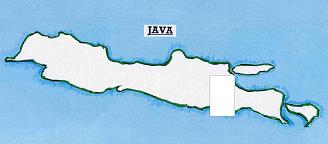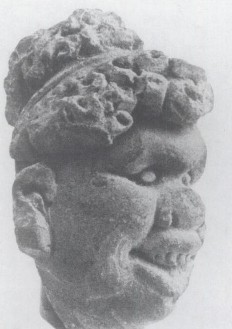To next page
Note on the Inscriptions found on Java
----------------------------------------------
In these inscriptions the word Jenggi is used (meaning Zanj). It can not be proven right now if this applies to East Africa or to Irian Yaya and nearby islands.
In the muslim world it was believed that Africa did not stretch south but east making Irian Yaya where people live resembling the Africans the most eastern part of Africa. People who really came from Africa would however also have been called Jenggi.
-At the beginning of the eighth century the Sriwijaya King, Indrawarman, included a native bird of Jenggi (Papua) (the Cenderawasih, �bird of paradise�) in his tribute to the Chinese emperor. The presentation of a cenderawasih was noted in the Chinese Yearbooks. Other authors however say that other interpretations of this passage are possible.
-Hui-lin in his Ch�ieh Ching Yin I (737-820) when talking about the Kunlun people: There are many races and varieties of them thus there are the Zangis, the Turmi, the Kurdang and the Khmer.
-Masudi (� 915) talks about the sea of China or Sandji, which is the furthest of all. G. P. Rouffaer identifies this with the sea of Djenggi or Papoea-sea from the Javanese history.
Other authors however say that what is meant here is the sea of Japan.
-Yang Xiu and Song Qi :Xin T'angshu (New history of the Tang Dynasty) (1060)
The book mentions an island called kat-kat Zangi country which was an island of the northwestern corner of Sumatra.
- Chia Tan in 800 mentions the Straits of Ko-Ko-seg-ti-Kuo (straits of Singapore)
-Chao yu Kua � 1200 mentions Tung ki, which authors think is the Jenggi or Papua
The book of Chu-fan-chi mentioned that Java was ruled by a maharaja, that rules several colonies: Pai-hua-yuan (Pacitan), Ma-tung (Medang), Ta-pen (Tumapel), Hi-ning (Dieng), Jung-ya-lu (Hujung Galuh), Tung-ki (Jenggi, west Papua), Ta-kang (Sumba), Huang-ma-chu (Southwest Papua), Ma-li (Bali), Kulun (Gurun, identified as Gorong or Sorong in Papua or an island in Nusa Tenggara), Tan-jung-wu-lo (Tanjungpura in Borneo), Ti-wu (Timor), Pingya-i (Banggai in Sulawesi), and Wu-nu-ku (Maluku).
I make however a so complete as possible list of all inscriptions found as they are so often mentioned by writers to be related to African people and try to give a translation. Mentions that clearly refer to Papua are not listed. The translations tend to show Jenggi are African. All texts and inscriptions are from a later date then the examples given on top.

The language used is always old Javanese (also called Kawi). This language was only spoken in East and Central Java. After the middle ages the word Jenggi spread to middle-Javanese and also to a number of other languages in South East Asia and has today the meaning of African.
Black people as servants were rather common in the middle ages in Java as is attested in the sculptures of the temples of Borobodur and Prembanan. Most of them will have had other origins then Africa.
The inscription: wenan ahuluna(to own as slaves) pujut(Negrito slave) bondan(slave from Papua? origin) jengi(black slave)
Or the text from a book: bondan sajuru lawan ikan pujut sajuru jengi sajuru humadan in which bondan, pujut and jengi are used would if we could be sure of the translation solve the problem.
The context in which the word Jengi is used in the inscriptions is always an enumeration of different categories of slaves. And then statements are made that the community is allowed to own those kinds of slaves or that those kind of slaves belonging to neighboring officials are not allowed to show up in that community. In books the word appears also and not always in lists of slaves.
